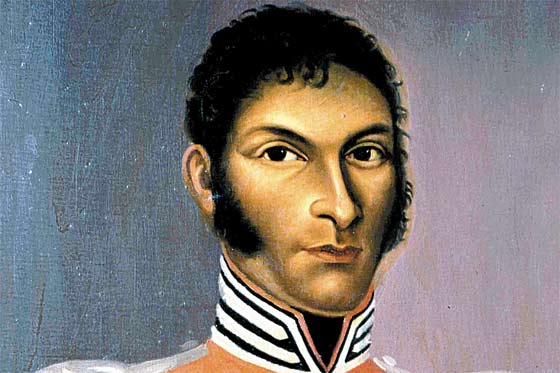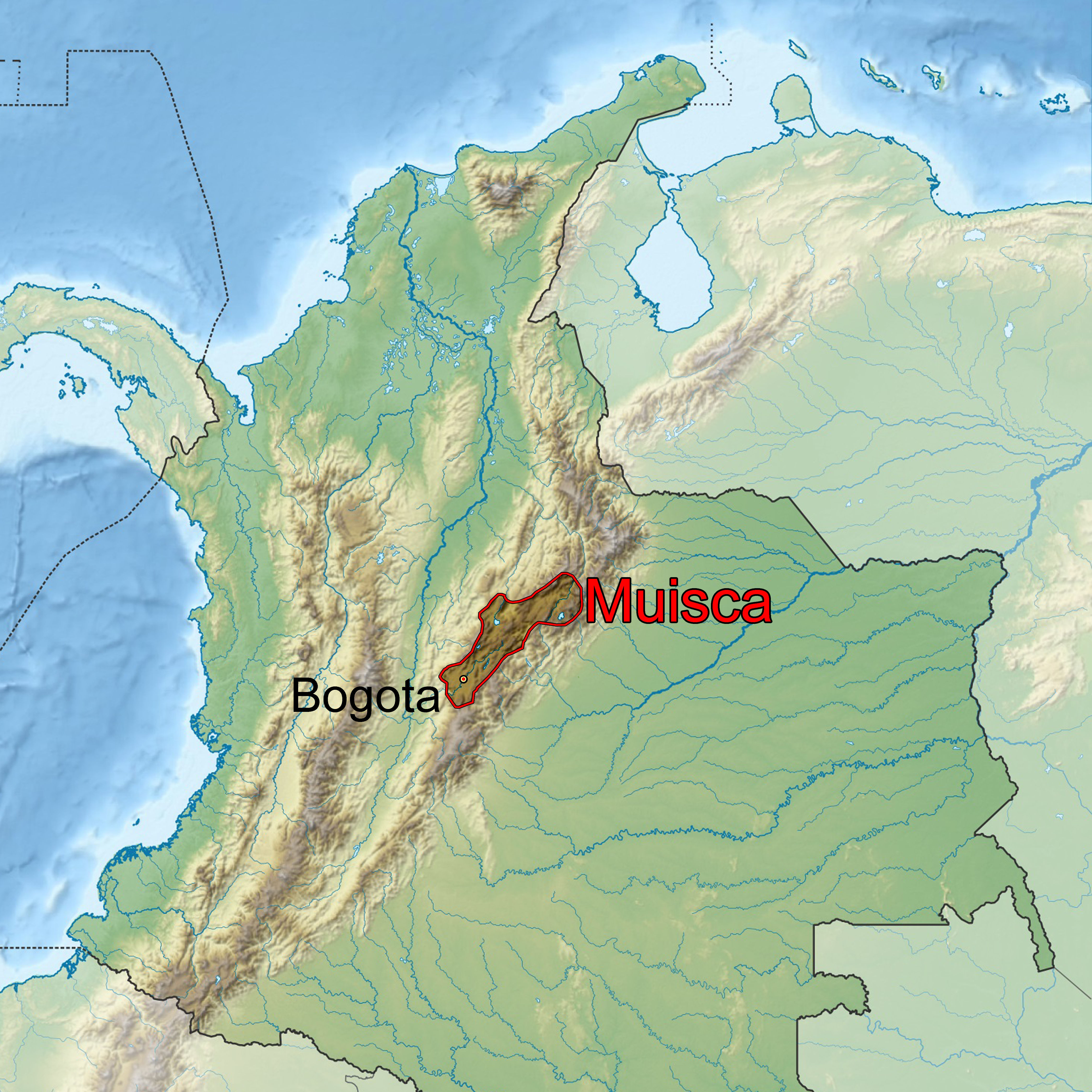|
Ramiriquí
Ramiriquí is a town and municipality in the Colombian Department of Boyacá, part of the subregion of the Márquez Province. Ramiriquí borders the department capital Tunja in the north, in the south Chinavita and Zetaquirá, in the east Rondón and Ciénaga and in the west Chivatá, Tibaná and Jenesano.Official website Ramiriquí - accessed 02-05-2016 Etymology Ramiriquí was named after the last ''cacique''; Ramirique. In the of the Muisca ''Ramirraquí'' means "white earth". An alternative etymology is ''Ca-mi-quiquí'' which means "our strength over the grasslands".[...More Info...] [...Related Items...] OR: [Wikipedia] [Google] [Baidu] |
Goranchacha
Goranchacha was a mythical ''cacique'' who was said to have been the prophet of the Muisca of South America, in particular of the '' zacazgo'' of the northern Muisca Confederation. He is considered the son of the Sun, impersonated by the Sun god Sué.Ocampo López, 2013, Ch.13 p.79 Background In the centuries before the arrival of the Spanish conquistadores the central highlands of Colombia were ruled by ''zaques'' (northern Muisca Confederation) and ''zipas'' (southern territories). The Muisca had two main deities; Sué, the Sun, and his wife Chía, the goddess of the Moon. Mythography According to the Muisca legends, the Sun wanted to reincarnate in human form and performed this via a maid of the village of Guachetá. The maid stayed a virgin because she gave birth after receiving rays of sunlight. This miracle became known in the village and the whole region around it. Upon this curious event, every day the daughters of the ''cacique'' of Guachetá left their ''bohíos' ... [...More Info...] [...Related Items...] OR: [Wikipedia] [Google] [Baidu] |
Quemuenchatocha
Quemuenchatocha or Quimuinchateca (named in the earliest sources Eucaneme) ( Hunza, 1472– Ramiriquí, 1538) was the second-last '' hoa'' of Hunza, currently known as Tunja, as of 1490. He was the ruler of the northern Muisca when the Spanish conquistadores arrived in the Muisca highlands. His contemporary enemy '' psihipquas'' of the southern Muisca were successively Nemequene and Bogotá. Biography Eucaneme was eighteen years old when he accessed the throne, succeeding his predecessor Michuá as ruler of the northern Muisca. His reign was cruel and under his tyranny the Muisca feared him. His rule was so brutal that when the Spanish conquerors entered the outskirts of the capital Hunza and found a hill with poles where bodies were dangling, they named it ''Cerro de la Horca'' ("Gallows Hill").Biography of ... [...More Info...] [...Related Items...] OR: [Wikipedia] [Google] [Baidu] |
Rondón, Boyacá
Rondón is a town and municipality in the Márquez Province, part of Boyacá Department, Colombia. The urban centre of Rondón is situated at an altitude of on the Altiplano Cundiboyacense in the Colombian Eastern Ranges of the Andes. It is away from the departmental capital Tunja. Rondón borders Viracachá and Siachoque in the north, Zetaquirá and Ramiriquí in the south, Pesca in the east and Ramiriquí and Ciénega in the west. Etymology Previously, Rondón was called San Rafael. In earlier times, the area of Rondón was known as a forested terrain called La Galera. It received the name Rondón honouring the independence hero of the Battle of Vargas Swamp Juan José Rondón. History The terrain of Rondón was completely forested until the mid 19th century, when the lands passed through various families of land owners. The newly founded settlement was populated by people coming from Ramiriquí, Ciénega, Viracachá and Pesca. The town received the status of ... [...More Info...] [...Related Items...] OR: [Wikipedia] [Google] [Baidu] |
Márquez Province
The Márquez Province is a province of Boyacá Department, Colombia. The province is formed by 10 municipalities. Municipalities Boyacá • Ciénaga • Jenesano • Nuevo Colón • Ramiriquí • Rondón • Tibaná • Turmequé • Úmbita • Viracachá Viracachá is a town and municipality in the Márquez Province, Colombia, part of the Colombian department of Boyacá. Viracachá is situated on the Altiplano Cundiboyacense at from the department capital Tunja and the small urban center at abo ... References External links Boyaca Info; Provinces of Boyaca Provinces of Boyacá Department {{Boyacá-geo-stub ... [...More Info...] [...Related Items...] OR: [Wikipedia] [Google] [Baidu] |
Tunja
Tunja () is a city on the Eastern Ranges of the Colombian Andes, in the region known as the Altiplano Cundiboyacense, 130 km northeast of Bogotá. In 2018 it had a population of 172,548 inhabitants. It is the capital of Boyacá department and the Central Boyacá Province. Tunja is an important educational centre of well-known universities. In the time before the Spanish conquest of the Muisca, there was an indigenous settlement, called Hunza, seat of the ''hoa'' Eucaneme, conquered by the Spanish conquistadors on August 20, 1537. The Spanish city was founded by captain Gonzalo Suárez Rendón on August 6, 1539, exactly one year after the capital Santafé de Bogotá. The city hosts the most remaining Muisca architecture: Hunzahúa Well, Goranchacha Temple and Cojines del Zaque. Tunja is a tourist destination, especially for religious colonial architecture, with the Casa Fundador Gonzalo Suárez Rendón as oldest remnant. In addition to its religious and historical ... [...More Info...] [...Related Items...] OR: [Wikipedia] [Google] [Baidu] |
Chinavita
Chinavita is a town and municipality in the Neira Province, part of the Colombian department of Boyacá. The urban centre of Chinavita is located at from the department capital Tunja on the Altiplano Cundiboyacense and the municipality borders Tibaná and Ramiriquí in the north, Ramiriquí and Miraflores in the east, Garagoa in the south and in the west Pachavita and Úmbita. Etymology The name Chinavita is derived from Chibcha and means "illuminated hilltop". Another explanation is "our hill".Etymology Chinavita - Excelsio.net History The area of Chinavita before the was inhabited by the |
Muisca Confederation
The Muisca Confederation was a loose confederation of different Muisca rulers (''zaques'', ''zipas'', ''iraca'', and ''tundama'') in the central Andes, Andean highlands of present-day Colombia before the Spanish conquest of the Americas, Spanish conquest of northern South America. The area, presently called Altiplano Cundiboyacense, comprised the current departments of Colombia, departments of Boyacá Department, Boyacá, Cundinamarca Department, Cundinamarca and minor parts of Santander Department, Santander. According to some List of Muisca scholars, Muisca scholars the Muisca Confederation was one of the best-organized confederations of tribes on the South American continent. Modern anthropologists, such as Jorge Gamboa Mendoza, attribute the present-day knowledge about the confederation and its organization more to a reflection by Spanish chroniclers who predominantly wrote about it a century or more after the Muisca were conquered and proposed the idea of a loose collection o ... [...More Info...] [...Related Items...] OR: [Wikipedia] [Google] [Baidu] |
Spanish Conquest Of The Muisca
The Spanish conquest of the Muisca took place from 1537 to 1540. The Muisca were the inhabitants of the central Andean highlands of Colombia before the arrival of the Spanish conquistadors. They were organised in a loose confederation of different rulers; the '' psihipqua'' of Muyquytá, with his headquarters in Funza, the ''hoa'' of Hunza, the '' iraca'' of the sacred City of the Sun Sugamuxi, the Tundama of Tundama, and several other independent ''caciques''. The most important rulers at the time of the conquest were ''psihipqua'' Tisquesusa, ''hoa'' Eucaneme, ''iraca'' Sugamuxi and Tundama in the northernmost portion of their territories. The Muisca were organised in small communities of circular enclosures (''ca'' in their language Muysccubbun; literally "language of the people"), with a central square where the '' bohío'' of the ''cacique'' was located. They were called "Salt People" because of their extraction of salt in various locations throughout their ter ... [...More Info...] [...Related Items...] OR: [Wikipedia] [Google] [Baidu] |
Municipalities Of Colombia
The Municipalities of Colombia are decentralized subdivisions of the Republic of Colombia. Municipalities make up most of the departments of Colombia with 1,122 municipalities ('' municipios''). Each one of them is led by a mayor (''alcalde'') elected by popular vote and represents the maximum executive government official at a municipality level under the mandate of the governor of their department which is a representative of all municipalities in the department; municipalities are grouped to form departments. The municipalities of Colombia are also grouped in an association called the ''Federación Colombiana de Municipios'' (Colombian Federation of Municipalities), which functions as a union under the private law and under the constitutional right to free association to defend their common interests. Categories Conforming to the law 1551/12 that modified the sixth article of the law 136/94 Article 7 http://www.alcaldiabogota.gov.co/sisjur/normas/Norma1.jsp?i=48267 the mu ... [...More Info...] [...Related Items...] OR: [Wikipedia] [Google] [Baidu] |
Muisca Mythology
Knowledge of Muisca mythology has come from Muisca scholars Javier Ocampo López, Pedro Simón, Lucas Fernández de Piedrahita, Juan de Castellanos and conquistador Gonzalo Jiménez de Quesada who was the European making first contact with the Muisca in the 1530s. Muisca mythology The times before the Spanish conquest of the Muisca Confederation are filled with mythology. The first confirmed human rulers of the two capitals Hunza and Bacatá are said to have descended from mythical creatures. Apart from that other Muisca myths exist, such as the legendary ''El Dorado'' and the Monster of Lake Tota. Mythological creatures Several mythological creatures have been described by the chroniclers: * Thomagata, said to have been one of the most religious of the ''zaques'', after Idacansás * Idacansás, allegedly a mythical priest from Sugamuxi who was able to change the order of things * Goranchacha, a mythical ''cacique'' who moved the capital of the northern Muisca from ... [...More Info...] [...Related Items...] OR: [Wikipedia] [Google] [Baidu] |
Muisca People
The Muisca (also called Chibcha) are an indigenous peoples of Colombia, indigenous people and Pre-Columbian cultures of Colombia, culture of the Altiplano Cundiboyacense, Colombia, that formed the Muisca Confederation before the Spanish conquest of the Muisca, Spanish conquest. The people spoke Muysccubun, a language of the Chibchan languages, Chibchan language family, also called ''Muysca'' and ''Mosca''. They were encountered by list of conquistadors in Colombia, conquistadors dispatched by the Spanish Empire in 1537 at the time of the Spanish conquest of the Muisca, conquest. Subgroupings of the Muisca were mostly identified by their allegiances to three great rulers: the ''zaque, hoa'', centered in Tunja, Hunza, ruling a territory roughly covering modern southern and northeastern Boyacá Department, Boyacá and southern Santander Department, Santander; the ''zipa, psihipqua'', centered in Bacatá, Muyquytá and encompassing most of modern Cundinamarca Department, Cundinama ... [...More Info...] [...Related Items...] OR: [Wikipedia] [Google] [Baidu] |
Tibaná
Tibaná is a town and municipality in the Colombian Department of Boyacá, part of the subregion of Márquez Province. The urban centre of Tibaná is situated on the Altiplano Cundiboyacense at an altitude of and a distance of from the department capital Tunja. It borders Jenesano in the north, Ramiriquí and Chinavita in the east, Chinavita and Úmbita in the south and in the west Turmequé and Nuevo Colón. Etymology Tibaná is named after the ''Tibanaes'', a Chibcha-speaking tribe of the Muisca. ''Tiba'' means "chief".Etymology Tibaná - Excelsio.net History The area around Tibaná was part of the and loyal to th ...[...More Info...] [...Related Items...] OR: [Wikipedia] [Google] [Baidu] |





